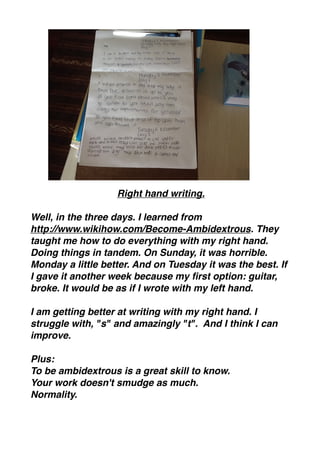Right hand writing
- 1. Right hand writing. Well, in the three days. I learned from http://www.wikihow.com/Become-Ambidextrous. They taught me how to do everything with my right hand. Doing things in tandem. On Sunday, it was horrible. Monday a little better. And on Tuesday it was the best. If I gave it another week because my ïŽrst option: guitar, broke. It would be as if I wrote with my left hand. I am getting better at writing with my right hand. I struggle with, "s" and amazingly "t". And I think I can improve. Plus: To be ambidextrous is a great skill to know. Your work doesn't smudge as much. Normality.
- 2. Minus: It comes out horrible. You can't read it. Your hand shakes rapidly. It hurts your ïŽngers. I can't see over my hand. Interesting: When you your calm it comes out horrible. But when your aggressive the result is better. The easier letters like, "l" and "t" are the most difïŽcult as well as "s". It takes a lot of focus, even more focus than when you are in a test. You feel like you have to do everything with your right hand. In class, I have urges to write with my right hand. Then I remember the awful result I do with my right hand. The ïŽrst day, I couldn't read it one bit. The second day a bit better. And the third, I was able to read it clearly. In the future I don't see me using my right hand full time.

